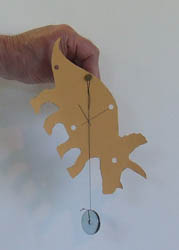What's the dinosaur's Balance Point?
Dinosaur Activity
In this dinosaur activity you will create a dinosaur out of paper. Next, you determine if your dinosaur walked on 2 legs or 4 legs. You might also create a dinosaur out of clay and see if it walked on 2 feet or 4 feet as it traveled from place to place.
Materials
- Cardboard
- Scissors
- Paper punch
- Nail
- Light string
- Nut or washer
Directions
- Create a picture of a dinosaur on a piece
of light cardboard.
- You can either draw a picture of an imaginary
dinosaur or copy a picture of a dinosaur for this activity.
- Cut the
dinosaur's picture out with scissors so you just have the shape of the
dinosaur.
- Use a paper punch to make at least two holes in the dinosaur. One toward the front end of the dinosaur and one toward its back end.
- Cut a piece of string about 12 inches long.
- Make a loop in one
end of the string.
- Tie the other end to the nut or washer that you will
be using as a weight.
- Slip the nail through the loop of the string. Push
the nail through one of a hole in the front half of the dinosaur. Make
sure the string and the cardboard hang freely.
- Make a pencil mark where
the string touches the dinosaur's body.
- Repeat these steps through a
hole in the back end of the dinosaur.
- The center of gravity of your dinosaur is where the lines intersect.
- If the center of gravity is over the hind legs then the dinosaur
walked on two legs. If the center of gravity is forward of the hind legs
it walked on four legs.
- If you have some plastic dinosaurs you can determine their center of gravity by tying a string around your pointer finger.
- Hold the plastic dinosaurs lightly at different points on their body to see where the string lies on the dinosaurs body.
- After you have done this several times you should be able to determine each plastic dinosaurs center of gravity.


Click for More Information and to Order
Science behind the activity
Scientists discovered that an animals center of gravity determines whether it is bipedal (walks on 2 legs) or quadrupedal (walks on 4 legs). If a bipedal animal has a tail, like some lizards, it helps them with their balance when leaning forward and running on two legs.
KIDS FUN Science Bookstore
Check out Myrna Martin's award winning textbooks, e-books, videos and rock sets. The Kids Fun Science Bookstore covers a wide range of earth science topics. Click here to browse.











